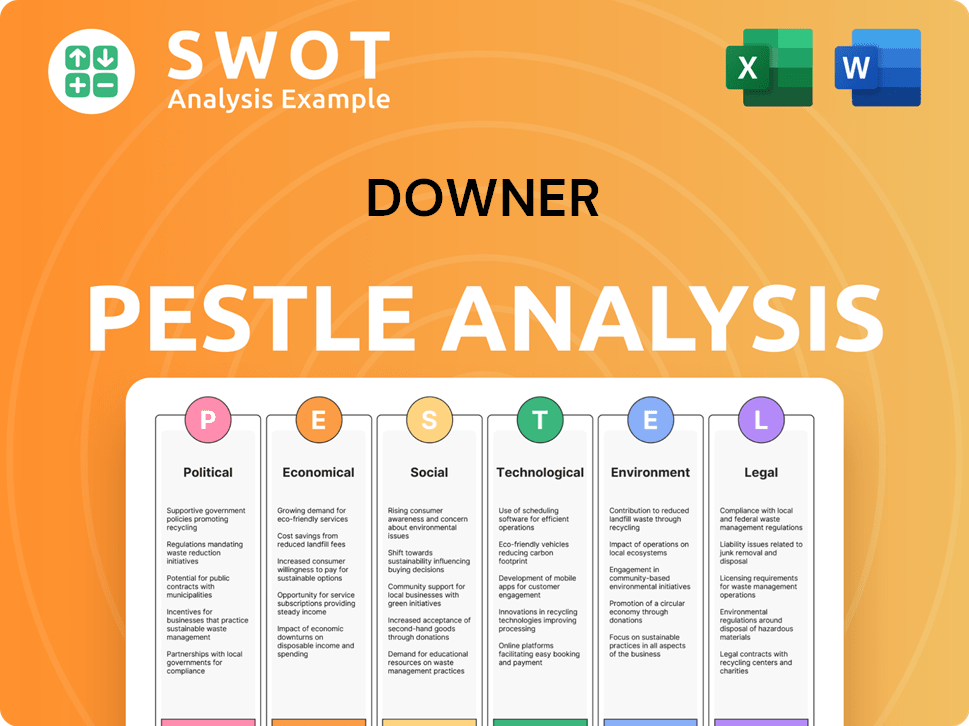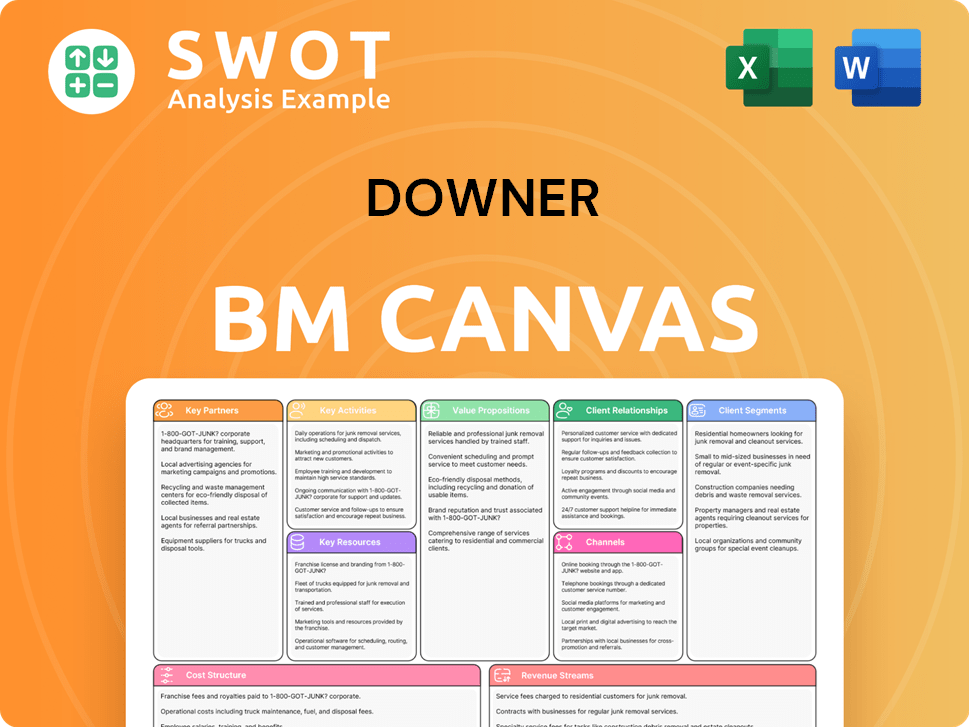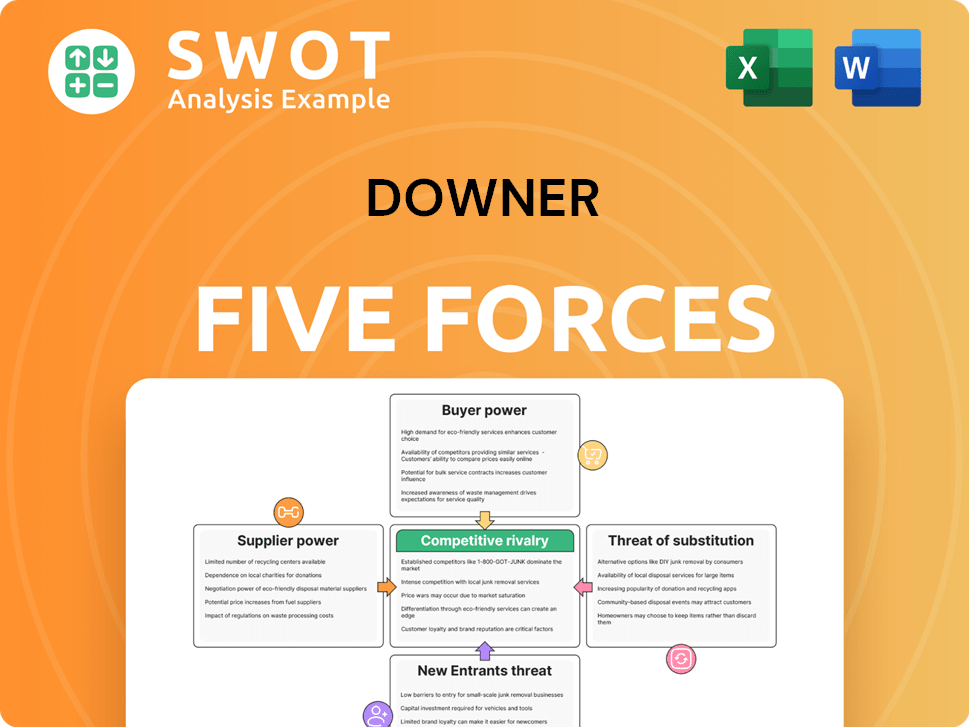Downer Bundle
Who Really Controls Downer Company?
Understanding the Downer SWOT Analysis is just the beginning; knowing who owns Downer is key to unlocking its potential. From its humble beginnings to its current status as a major player, Downer's ownership story is one of strategic shifts and significant acquisitions. The full acquisition of Spotless in 2020, for instance, reshaped its operational landscape. This article dives deep into the Downer Company ownership to reveal the forces driving its future.

This exploration into Who owns Downer will examine the Downer Group owner structure, from its founders to its current major stakeholders. We'll investigate the influence of the Board of Directors and recent developments that shape its ownership profile. By understanding the Downer shareholders and Downer business structure, you'll gain valuable insights into the company's strategic direction and financial performance, including the role of Downer management.
Who Founded Downer?
The story of Downer Group's ownership begins in the 19th century, with roots in Australian and New Zealand engineering and construction firms. These early entities, including Walkers Limited and Clyde Engineering in Australia, and the Public Works Department and Electrical Telegraph Department in New Zealand, laid the groundwork for what would become the Downer Group. This diverse heritage highlights the company's long-standing involvement in infrastructure development.
The official founding of Downer & Co. in 1933 by Arnold Downer in New Zealand marked a pivotal moment. Arnold Downer's vision centered on providing essential engineering and construction services for public and private infrastructure within New Zealand. This focus on nation-building projects has remained a core aspect of the company's identity throughout its history.
The evolution of Downer's ownership structure is characterized by strategic mergers and acquisitions. The merger with William Cable Holdings in 1954 and A&G Price in 1964, leading to the formation of Cable Price Downer, showcases the company's growth through consolidation. While specific details on the initial shareholding percentages of the founders and early investors are not readily available, these mergers significantly shaped the early ownership landscape.
Downer & Co. was officially founded in 1933 in New Zealand by Arnold Downer.
The company merged with William Cable Holdings in 1954 and A&G Price in 1964.
The company's primary focus remained on infrastructure development.
The early ownership structure was shaped by the integration of various engineering and construction entities.
Arnold Downer's vision was centered on providing essential engineering and construction services.
The founding team's commitment was to nation-building projects.
Understanding the early ownership of Downer Company provides a foundation for analyzing its current structure. For more detailed insights into the company's operations, you can explore the Revenue Streams & Business Model of Downer. The company's history shows a consistent strategic approach to growth, with mergers and acquisitions playing a key role in expanding its capabilities and market presence. While specific details on the initial shareholders aren't widely available, the mergers indicate a dynamic ownership structure that evolved over time, reflecting the company's commitment to infrastructure development.
Downer SWOT Analysis
- Complete SWOT Breakdown
- Fully Customizable
- Editable in Excel & Word
- Professional Formatting
- Investor-Ready Format

How Has Downer’s Ownership Changed Over Time?
The journey of Downer EDI Limited to becoming a publicly listed entity on the Australian Securities Exchange (ASX) in 1998 marked a significant turning point in its ownership structure. This transition from private and merged entities to a publicly traded company allowed for increased investment opportunities and greater transparency. A pivotal moment was the merger in March 2001 of Cable, Price, Downer with Evans Deakin Industries (EDI), forming the Downer EDI Group, which solidified its presence on the ASX and set the stage for its current ownership landscape.
The evolution of the Downer Group's ownership has been marked by strategic decisions that have reshaped its business structure. For instance, the divestment of its Australian Transport Projects business to Gamuda Berhad in the fiscal year ending June 30, 2023, and the acquisition of full ownership of Spotless in October 2020 for $1.27 billion, directly impacted the company's strategy and financial performance. These actions reflect the dynamic nature of Downer's business model and its adaptation to market conditions.
| Event | Date | Impact on Ownership |
|---|---|---|
| Initial Public Offering (IPO) | 1998 | Transition to public ownership, increased investor base. |
| Merger with EDI | March 2001 | Formation of Downer EDI Group, expanded market presence. |
| Acquisition of Spotless | October 2020 | Expansion of service offerings, strategic realignment. |
| Divestment of Australian Transport Projects | June 30, 2023 | Focus on core business areas, capital reallocation. |
As of May 2025, the market capitalization of Downer stands at approximately AUD 4.08 billion. The ownership structure of Downer EDI Limited (ASX: DOW) is primarily institutional, with institutions holding about 82.6% of the shares. The general public holds around 17%, and individual insiders and private companies hold smaller percentages. Understanding the Brief History of Downer provides context on the company's evolution and the factors influencing its ownership.
Downer's ownership is largely controlled by institutional investors, reflecting its status as a publicly traded company.
- Institutional investors hold a significant majority of shares, influencing strategic decisions.
- Major shareholders include firms like Ubique Asset Management and Orbis Investment Management.
- Strategic moves, such as acquisitions and divestitures, shape the company's trajectory.
- The ownership structure is dynamic, with shifts reflecting market performance and investor confidence.
Downer PESTLE Analysis
- Covers All 6 PESTLE Categories
- No Research Needed – Save Hours of Work
- Built by Experts, Trusted by Consultants
- Instant Download, Ready to Use
- 100% Editable, Fully Customizable

Who Sits on Downer’s Board?
The current leadership of the Downer Company includes Mr. Peter Tompkins as the Managing Director and Chief Executive Officer. Mr. Mark Menhinnitt serves as the Independent Non-Executive Chairman. The Board of Directors is responsible to shareholders for the company's operations, performance, and growth. Downer's management is accountable to the Board. New directors participate in a structured program that includes site visits and meetings with senior executives to understand the company's operations. They are also encouraged to take professional development courses, with the Company Secretary organizing governance and continuing education sessions for the Board.
Downer's corporate governance framework focuses on promoting leading practices, including identifying and managing business risks and effective communication with shareholders and the investment community. As a publicly listed company on the ASX and NZX, Downer generally operates under a one-share-one-vote structure for its ordinary shares. The company's commitment to good governance is crucial, especially given its public listing and the scrutiny that comes with it. The board's structure and practices are designed to ensure accountability and transparency.
| Role | Name | Title |
|---|---|---|
| Managing Director and CEO | Mr. Peter Tompkins | Chief Executive Officer |
| Independent Non-Executive Chairman | Mr. Mark Menhinnitt | Chairman |
| Board of Directors | Various | Directors |
In 2023, Downer faced a shareholder class action lawsuit related to a maintenance contract in its Australian Utilities business, impacting financial performance and earnings guidance in 2022. Downer has filed its defense and a Third Party Statement of Claim against its auditor, KPMG. This has led to KPMG ceasing to act as Downer's auditor, and a replacement will be appointed for the financial year ending June 30, 2024. These events highlight the importance of robust financial reporting and governance practices, which can influence decision-making within the company. Understanding the Growth Strategy of Downer is essential for investors.
Downer is a publicly listed company, which means it is owned by its shareholders. The company operates under a one-share-one-vote structure for its ordinary shares. The Board of Directors is accountable to shareholders for the company's operations, performance, and growth.
- The CEO is Mr. Peter Tompkins.
- The Chairman is Mr. Mark Menhinnitt.
- Downer's ownership structure is designed to ensure accountability and transparency.
- Shareholder class action lawsuits can impact financial performance.
Downer Business Model Canvas
- Complete 9-Block Business Model Canvas
- Effortlessly Communicate Your Business Strategy
- Investor-Ready BMC Format
- 100% Editable and Customizable
- Clear and Structured Layout

What Recent Changes Have Shaped Downer’s Ownership Landscape?
Over the past few years, the ownership profile of the Downer Company has seen significant shifts driven by strategic initiatives. These changes primarily involve divestments aimed at streamlining the company's portfolio and concentrating on core urban services. An important move was the sale of its Australian Transport Projects business in the year ended June 30, 2023, to a subsidiary of Gamuda Berhad. This aligns with Downer's strategy to enhance value creation in key markets, focusing on opportunities with a lighter capital profile. The ongoing focus is to optimize the existing public structure and boost profitability within its core sectors, reflecting a dynamic approach to Downer Group's marketing strategy.
A notable recent development in ownership changes is the completion of Downer's exit from its laundries business. On April 24, 2025, Downer finalized the sale of its remaining 29.9% interest in its Australian laundries business (HT Hold Co Pty Ltd) to an Asia Pacific private equity fund managed by Macquarie Asset Management. This follows the earlier sale of 70.1% of the business to Adamantem Capital in 2021. From this final sale, Downer received approximately $64 million in pre-tax proceeds. These divestments are designed to strengthen Downer's financial position and provide flexibility in capital allocation.
| Metric | Details | Data |
|---|---|---|
| Institutional Ownership | Percentage of shares held by institutions | Over 82% |
| Laundries Business Sale | Final sale of remaining interest | April 24, 2025 |
| Proceeds from Laundries Sale | Pre-tax proceeds from the final sale | Approximately $64 million |
Industry trends often show increased institutional ownership, which is evident in Downer's shareholder base, where institutions hold over 82% of shares. While there haven't been public statements about planned full privatization or a new public listing, the strategic divestments indicate a focus on optimizing its existing public structure and enhancing profitability within its core sectors. Downer also continues to invest in leadership capability and succession planning, as evidenced by the appointment of Peter Tompkins as CEO and Managing Director in February 2023, an internal successor. This suggests a commitment to internal talent development and stable leadership, which can be attractive to long-term investors.
Downer Company ownership structure is primarily public, with a significant portion of shares held by institutional investors. The company has undertaken strategic divestments to streamline its portfolio.
Recent changes include the sale of the Australian Transport Projects business and the exit from the laundries business. These moves aim to strengthen the company's financial position.
Downer's strategy focuses on core urban services and optimizing its public structure. The company is also investing in leadership and succession planning.
The company's focus on core sectors and internal leadership development suggests a commitment to long-term value creation for Downer shareholders.
Downer Porter's Five Forces Analysis
- Covers All 5 Competitive Forces in Detail
- Structured for Consultants, Students, and Founders
- 100% Editable in Microsoft Word & Excel
- Instant Digital Download – Use Immediately
- Compatible with Mac & PC – Fully Unlocked

Related Blogs
- What are Mission Vision & Core Values of Downer Company?
- What is Competitive Landscape of Downer Company?
- What is Growth Strategy and Future Prospects of Downer Company?
- How Does Downer Company Work?
- What is Sales and Marketing Strategy of Downer Company?
- What is Brief History of Downer Company?
- What is Customer Demographics and Target Market of Downer Company?
Disclaimer
All information, articles, and product details provided on this website are for general informational and educational purposes only. We do not claim any ownership over, nor do we intend to infringe upon, any trademarks, copyrights, logos, brand names, or other intellectual property mentioned or depicted on this site. Such intellectual property remains the property of its respective owners, and any references here are made solely for identification or informational purposes, without implying any affiliation, endorsement, or partnership.
We make no representations or warranties, express or implied, regarding the accuracy, completeness, or suitability of any content or products presented. Nothing on this website should be construed as legal, tax, investment, financial, medical, or other professional advice. In addition, no part of this site—including articles or product references—constitutes a solicitation, recommendation, endorsement, advertisement, or offer to buy or sell any securities, franchises, or other financial instruments, particularly in jurisdictions where such activity would be unlawful.
All content is of a general nature and may not address the specific circumstances of any individual or entity. It is not a substitute for professional advice or services. Any actions you take based on the information provided here are strictly at your own risk. You accept full responsibility for any decisions or outcomes arising from your use of this website and agree to release us from any liability in connection with your use of, or reliance upon, the content or products found herein.